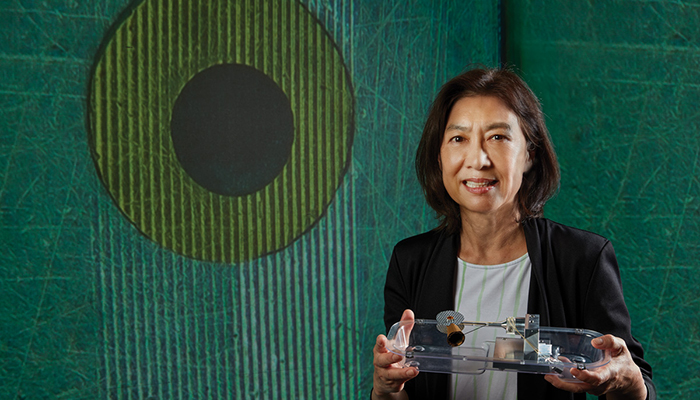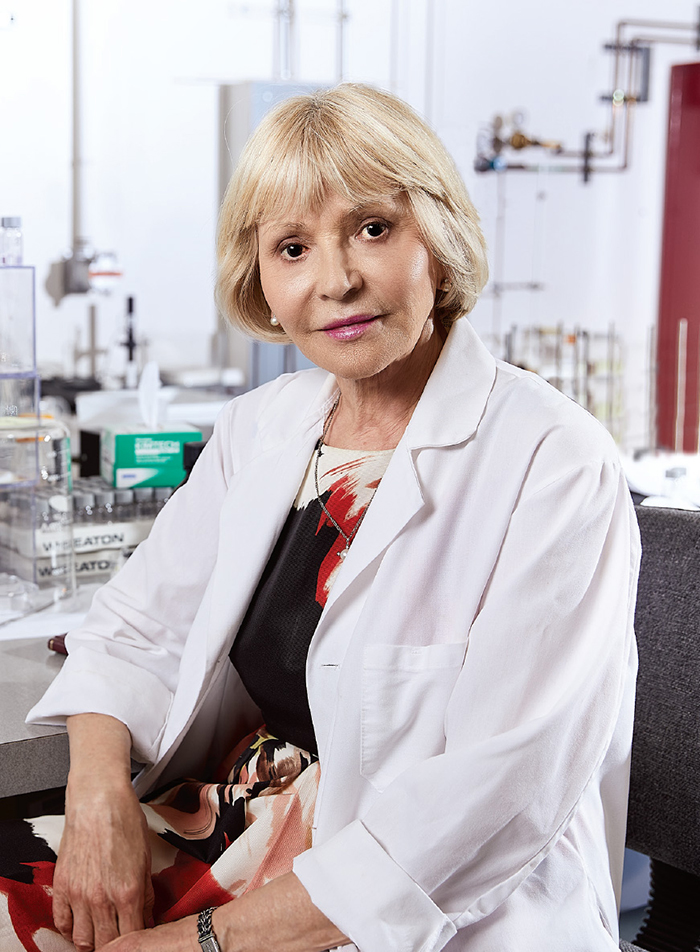Shining a Light on Technical Excellence
March 31, 2022
 Physicist Hye-Sook Park holds a NIF target assembly. Her work at NIF includes studying solid-state dynamic material properties and high-speed plasma flow interactions. Photos by Garry McLeod
Physicist Hye-Sook Park holds a NIF target assembly. Her work at NIF includes studying solid-state dynamic material properties and high-speed plasma flow interactions. Photos by Garry McLeod The following is an excerpt from a story by Ann Parker in the September/October 2021 issue of Science & Technology Review:
Climbing the management ladder is not the only upward route on a career path, a fact long recognized by Lawrence Livermore National Laboratory (LLNL). Ten years ago, the Laboratory established the Distinguished Member of Technical Staff (DMTS) program to provide a career path for advancement for those who choose to remain working in their technical fields rather than step out, full time, onto the managerial track.
“Our Lab was created to bring innovative science and technology to bear to tackle the most significant challenges facing the nation and the world,” LLNL Director Kimberly Budil said. “To do this well requires a high level of technical excellence, so it is critically important that we develop exceptional leaders in our science and technology ranks. The DMTS program was created to recognize these exceptional leaders from across the Lab and to shine a light on their extensive expertise and many contributions.”
Appointment to the DMTS level is the highest technical staff level achievable at the Laboratory. Those who are nominated to DMTS have a history of high-level achievement in important LLNL programs or distinguished scientific achievements. They are often recognized authorities in their fields responsible for important discoveries with lasting impacts.
Laboratory leaders nominate candidates at the request of the director, who decides when to open nominations. The last DMTS staff were named in 2019. A sample of DMTS members, from the early years of the program to the most recent induction, demonstrates that the word “outstanding” truly applies.
Hye-Sook Park
In 2017, physicist Hye-Sook Park was 30 years into her Livermore career and leading multiple projects at NIF. Among her projects was a successful campaign to develop a new “high foot” shape for NIF’s laser pulse that was more forgiving of fusion fuel capsule imperfections, the first plutonium strength experiment, and an astrophysical collisionless shock campaign.
“All of my projects were delivering incredible results, and I was in the middle of an exciting time,” Park said.
Adding to the excitement that year was the notification that she received the DMTS award.
“When I heard,” she said, “I gave two thumbs up and shouted, ‘Yes! I did it!’ I truly appreciated that the Laboratory and my nominator recognized my enthusiasm for science and my hard work, even though I did not follow a managerial track.”
Challenging, cutting-edge science is what Park thrives on—from her early projects working on the Clementine lunar mapping satellite mission and chasing after optical counterparts of galactic gamma-ray bursts that last only tens of seconds, to studying the density evolution of metal ejecta from high explosives.
“I wouldn’t be where I am now without my mentor’s and colleagues’ help,” she said. “Everything is a team effort.”
Park notes that she became a DMTS without an Ivy League degree and as a foreign-born woman. She offers the following advice to young scientists: “Find a good mentor and work hard.”
Natalia Zaitseva
 Natalia Zaitseva’s research on the growth mechanisms and physics properties of single crystals grown from low-temperature solutions has revolutionized the fields of crystal growth and radiation technology.
Natalia Zaitseva’s research on the growth mechanisms and physics properties of single crystals grown from low-temperature solutions has revolutionized the fields of crystal growth and radiation technology. Reflecting on receiving the DMTS award in 2015, Natalia Zaitseva says she was honored by the recognition, adding, “Any accomplishment I’ve been a part of became possible only because of the hard work and devotion of the people I’ve been privileged to work with.”
Her research, which focuses on the growth mechanisms and physics properties of single crystals grown from low-temperature solutions, has revolutionized the fields of crystal growth and radiation technology.
Her early work at the Laboratory included developing methods for rapid growth of super-large crystals for the NIF laser system. More recent research on developing new organic scintillation materials for radiation detection led to the development of the first plastic scintillators that differentiate between neutrons and gamma rays as well as a novel method for quickly growing organic single crystals, which was subsequently transferred to industry.
Zaitseva continues to develop new materials resulting in crystals with unique properties, including crystals that are the basis of solid-state organic scintillators that can be used for neutron spectroscopy and differentiation between fast and thermal neutrons.
“I am glad for the DMTS recognition, but it hasn’t changed how I work or the work that I do,” she said. “The Laboratory provides an excellent research environment for scientists. I feel privileged to work with an outstanding team and great colleagues and appreciate the opportunity to continue doing the work I love.”
To read the full story, which includes DMTS award winners Rob Falgout, Frank Graziani, and Larry Fried, go to Science & Technology Review.
More Information
“Experiments at NIF Mimic Supernova Shock Waves,” NIF & Photon Science News, June 11, 2020
“NIF Research Finds Lead Gets Harder Under Extreme Conditions,” NIF & Photon Science News, November 20, 2019
Pursuing a Challenging—and Rewarding—Career
“Five NIF Researchers Named DMTS,” NIF & Photon Science News, May 2015
—Ann Parker
Follow us on Twitter: @lasers_llnl



